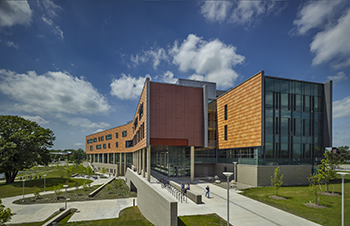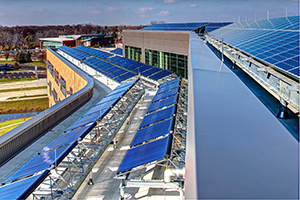Oakland University Shapes Health Professionals
 ROCHESTER, Mich. — The $64 million Oakland University Human Health Building (HHB) debuted in August 2012 and recently became the first LEED Platinum-certified building on a university campus in the state of Michigan.
ROCHESTER, Mich. — The $64 million Oakland University Human Health Building (HHB) debuted in August 2012 and recently became the first LEED Platinum-certified building on a university campus in the state of Michigan.
The HHB was built to accommodate the student enrollment increase that caused the university’s School of Nursing and School of Health Sciences to outgrow their separate facilities. The new building brings both schools together in a collaborative environment and is the first to be constructed as part of the university’s proposed Health Quadrant Campus Master Plan.
Designed by SmithGroupJJR (with offices in Detroit), the 160,260-square-foot building houses advanced classrooms and hands-on instructional spaces for students to learn in an environment that replicates that of a hospital or community health center. A public clinic, simulation labs, clinical and physical therapy labs are available to students.
The building was built on the former site of a parking lot and an untended natural wetland. Because it was being created for health sciences students, the university wanted the structure to incorporate healthy building practices.
“Environmentally friendly buildings have show to have positive effects on the quality of their occupants’ health, so it was easy for the university to decide that the new Human Health Building should be highly sustainable,” said Chris Purdy, AIA, LEED AP, Smith GroupJJR principle-in-charge for the project, in a statement.
 The facility’s energy systems cut energy costs by an estimated 35 percent annually compared to the LEED baseline building. A geothermal field consisting of 340 wells was built 320 feet below the university’s main parking lot and uses the earth to provide energy for heat pumps that heat and cool the building. The 117 vacuum tube solar thermal panels also provide heat for the building in the wintertime, as well as provide the desiccant dehumidification system in the summertime and domestic water heating throughout the year. Plus, four, 25,000-gallon underground takes store excess solar generated hot water until it’s needed. The building also features a rooftop photovoltaic system that consists of more than 200 solar panels, which provide 45 kilowatts or 3 percent of the building’s power.
The facility’s energy systems cut energy costs by an estimated 35 percent annually compared to the LEED baseline building. A geothermal field consisting of 340 wells was built 320 feet below the university’s main parking lot and uses the earth to provide energy for heat pumps that heat and cool the building. The 117 vacuum tube solar thermal panels also provide heat for the building in the wintertime, as well as provide the desiccant dehumidification system in the summertime and domestic water heating throughout the year. Plus, four, 25,000-gallon underground takes store excess solar generated hot water until it’s needed. The building also features a rooftop photovoltaic system that consists of more than 200 solar panels, which provide 45 kilowatts or 3 percent of the building’s power.
The building’s design focuses on sustainability, too. For instance, a porch created by the overhang of the upper floors protects faculty offices from solar heat gain. Exterior offices feature vertical sunshades and fritted glass that reduce glare and also cut down on outside heat. Rainwater is collected from the roof and stored in a below-grade cistern to be used for site irrigation.
The building’s interior features an elongated floor plan that includes floor-to-ceiling windows, allowing for natural light and expansive views of outdoor spaces. The materials used in the design such as sealed cork floors and bamboo cabinets are recycled, regional and low-VOC. The walls are also made with insulated cinderblock to reduce energy costs. There are daylight and occupant sensors throughout the building to help reduce energy used by occupants.
A 100-year-old oak tree stands on the south side of the building. It was incorporated into the site design instead of being cleared. The site’s natural wetland was also revived with native vegetation to provide an outdoor lounge for students to gather.
About $40 million of the project’s funding came from the state legislature’s Capital Outlay Program. To achieve LEED Platinum on a tight budget, Oakland University, assisted by SmithGroupJJR, also pursued a $2.7 million grant from the U.S. Department of Energy.
“This building was really geared towards the student population. Oakland wanted this building to be for the kids,” said Meredith McLellan, project manager for SmithGroupJJR. “Today’s students are really environmentally conscious, so it was actually something we heard from students as being a priority. When we got the opportunities through the grant, it was really the catalyst that allowed us to reach Platinum. It was really driven by that opportunity.”
